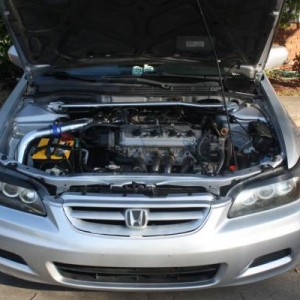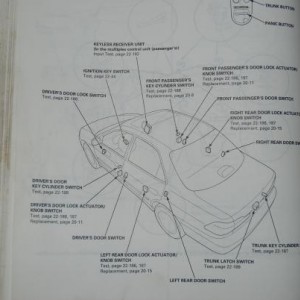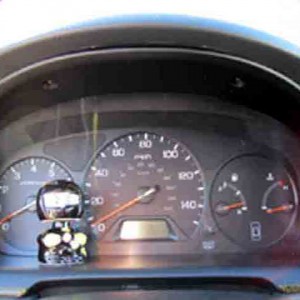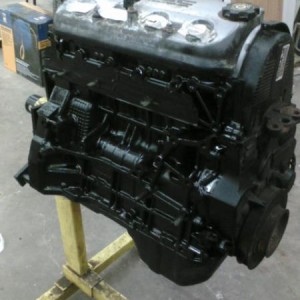03-016
May 19, 2006
Applies To:
1998-02 Accord -ALL
1996-00 Civic -ALL
1997-01 CR-V - ALL
1997-01 Prelude - ALL
*1999-04 Odyssey - ALL*
Inspecting Idle Speed With the PGM Tester or Honda Diagnostic System
(Supersedes 03-016, dated March 25, 2003, to update the information marked by asterisks)
BACKGROUND
The ECM/PCM controls the vehicle's idle speed with the idle air control (IAC) valve. The IAC valve and the air bleed screw (idle adjusting screw) work together to allow the proper amount of air into the intake manifold when the throttle valve is closed (the accelerator pedal is released).
The ECM/PCM "learns" to work the IAC valve based on the total amount of air entering the intake manifold. Air can enter the intake manifold from several sources, including the air bleed screw, but only the air bleed screw is adjustable. If any changes are made that alter this airflow, specifically with the air bleed screw, the ECM/PCM must learn new idle parameters.
When the air bleed screw is properly set, the ECM/PCM controls the engine's idle speed seamlessly. But when the air bleed screw is not properly set, either of these symptoms may be present:
^ Idle speed dips and then quickly recovers.
^ Engine stalls intermittently when it is just "off-idle." Here are the criteria for this symptom:
- The accelerator pedal is released but the driver's right foot rests over the pedal, causing just enough pressure for the ECM/PCM to detect an input, yet there is little or no throttle valve opening (the throttle valve is either not allowing any airflow or it is opened so slightly that more air supply is needed).
- The engine speed is about 1,250 rpm or less.
- The lockup clutch (A/T models) or the clutch (M/T models) is disengaged.
- All during this time, the driver's foot does not move and stays resting over the accelerator pedal.
- The air bleed screw is not set properly and does not allow enough airflow.
- The amount of "air leakage" into the intake manifold is very low. (The normal amount of air let into the intake manifold by sources other than the IAC valve, the air bleed screw, and normal operation of the throttle body can vary slightly from vehicle to vehicle.)
NOTE :"Air leakage" cannot be easily checked. If the first four criteria are met when the vehicle stalls, you can assume the last two criteria are met as well.
CORRECTIVE ACTION
L4 Models and 1999-00 Odyssey: Inspect the idle speed with the PGM Tester or Honda Diagnostic System (HDS) (see INSPECTION PROCEDURE A).
V6 Models except 1999-00 Odyssey: Inspect the idle speed with the PGM Tester or HDS, and clean out the throttle body if needed (see INSPECTION PROCEDURE B).
PARTS INFORMATION
Throttle Body Gasket (use only if needed): Refer to the parts catalog.
TOOL INFORMATION
PGM Tester with SN 320
or
Honda Diagnostic System with 1.006.004 or later software
REQUIRED MATERIALS
Carburetor Cleaner:
P/N 08732-0006, H/C 4713673
or
Throttle Plate and Induction Cleaner:
P/N 08732-9009, H/C 6204945
WARRANTY CLAIM INFORMATION
In warranty:
The normal warranty applies.
Inspect Idle Speed (L4 and V6 Models)
Operation Number: 120301
Flat Rate Time: 0.6 hour
Failed Part: P/N 16400-PAA-A61
H/C 5429006
*Defect Code: 07403
Symptom Code: 08901*
Skill Level: Repair Technician
Clean Throttle Body (V6 Models Except 1999-00 Odyssey)
Operation Number: 216001
Flat Rate Time: 0.6 hour
Failed Part: P/N 16400-PAA-A61
H/C 5429006
*Defect Code: 08103
Symptom Code: 08901*
Skill Level: Repair Technician
NOTE :Warranty claims for these labor operations must be submitted separately. Do not combine them on the same claim.
Out of warranty:
Any repair performed after warranty expiration may be eligible for goodwill consideration by the District Parts and Service Manager or your Zone Office. You must request consideration, and get a decision, before starting work.
INSPECTION PROCEDURE A
1. Access the air bleed screw on the throttle body.
2. Record the current setting of the screw:
^ Turn the screw clockwise, and count the number of turns (both full and partial) it takes to fully seat the screw.
^ Turn the screw counterclockwise back to its original setting.
^ Subtract the number of clockwise turns it took to seat the screw from 3-1/2. Record that number. Example: If it took two full turns to seat the screw, subtracting 3-1/2 from that gives you 1-1/2.
3. Start the engine, and let it warm up to its normal operating temperature (the cooling fan cycles twice).
4. Turn off all electrical items (A/C, audio unit defogger, lights, etc.). Center the steering wheel so there is no power steering load.
5. Connect the PGM Tester or HDS to the 16P data link connector (DLC).
6. Turn on the PGM Tester or HDS. Enter the VIN and odometer reading.
7. Follow the screen prompts on the PGM Tester or HDS to get to DATA LIST. Scroll down the list to IAC.
8. While watching the IAC counts on the PGM Tester or HDS, slowly turn the air bleed screw (either counterclockwise or clockwise) until the IAC count reaches 1 (or 7 for '99-00 Odyssey) or you have turned the screw counterclockwise a total of 3-1/2 turns. (Count the number of counterclockwise turns you have made, and add that number to the screw setting you recorded in step 2.)
^ If you see an IAC count of 1 (or 7 for '99-00 Odyssey), turn the screw clockwise 1/2 turn, and then go to step 9.
^ If you do not see an IAC count of 1 (or 7 for '99-00 Odyssey), and you have turned the screw counterclockwise a total of 3-1/2 turns, leave the screw set where it is. Go to step 9. You should never set the air bleed screw counterclockwise more than 3-1/2 turns from its seated position. If you set the screw further it could work itself out of the throttle body over time.
9. Let the engine idle for 10 minutes to allow the ECM/PCM to learn the new idle parameters.
10. Turn the ignition switch to LOCK (0). Turn off and disconnect the PGM Tester or HDS.
INSPECTION PROCEDURE B
1. Access the air bleed screw on the throttle body.
2. Record the current setting of the screw:
^ Turn the screw clockwise, and count the number of turns (both full and partial) it takes to fully seat the screw.
^ Turn the screw counterclockwise back to its original setting.
^ Subtract the number of clockwise turns it took to seat the screw from 3-1/2. Record that number. Example: If it took two full turns to seat the screw, subtracting 3-1/2 from that gives you 1-1/2.
3. Start the engine, and let it warm up to its normal operating temperature (the cooling fan cycles twice).
4. Turn off all electrical items (A/C, audio unit, defogger, lights, etc.). Center the steering wheel so there is no power steering load.
5. Connect the PGM Tester or HDS to the 16P data link connector (DLC).
6. Turn on the PGM Tester or HDS. Enter the VIN and odometer reading.
7. Follow the screen prompts on the PGM Tester or HDS to get to DATA LIST. Scroll down the list to IAC.
8. While watching the IAC counts on the PGM Tester or HDS, slowly turn the air bleed screw (either counterclockwise or clockwise) until the IAC count reaches 7 or you have turned the screw counterclockwise a total of 3-1/2 turns. (Count the number of counterclockwise turns you have made, and add that number to the screw setting you recorded in step 2.)
^ If you see an IAC count of 7, turn the screw clockwise 1/2 turn, and then go to step 14.
^ If you do not see an IAC count of 7, and you have turned the screw counterclockwise a total of 3-1/2 turns, leave the screw set where it is. Go to step 9. You should never set the air bleed screw counterclockwise more than 3-1/2 turns from its seated position. If you set the screw further it could work itself out of the throttle body over time.
9. Turn the ignition switch to LOCK (0). Remove the throttle body (see the Fuel and Emissions section of the appropriate service manual).
10. Open the throttle. Spray carburetor cleaner or throttle plate and induction cleaner into the throttle body to clean out any contaminants. Make sure you spray the cleaner through the back of the throttle body not the front, to avoid damaging the IAC valve.
11. Inspect the throttle body gasket, and replace it if needed. Reinstall the throttle body, making sure all cables are properly adjusted, the accelerator pedal works properly, and all hoses and cables are correctly routed.
12. Start the engine, and let it warm up to its normal operating temperature. Make sure all electrical items are turned off and the steering wheel is centered.
13. While watching the PGM Tester or HDS, slowly turn the air bleed screw until the IAC count reaches 7 or you have turned the screw counterclockwise a total of 3-1/2 turns.
^ If you see an IAC count of 7, turn the screw clockwise 1/2 turn, and then go to step 14.
^ If you do not see an IAC count of 7, leave the screw set at 3-1/2 turns. Go to step 14. You should never set the air bleed screw counterclockwise more than 3-1/2 turns from its seated position. If you set the screw further it could work itself out of the throttle body over time.
14. Let the engine idle for 10 minutes to allow the ECM/PCM to learn the new idle parameters.
Turn the ignition switch to LOCK (0). Turn off and disconnect the PGM Tester or HDS.







